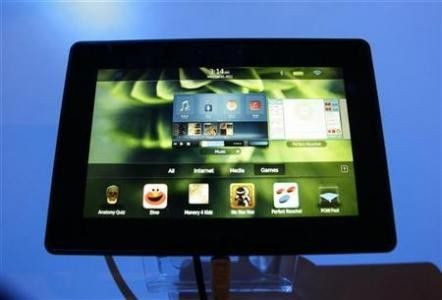RIM Upgrades PlayBook Tablet; BlackBerry Phone Software Improved

Research In Motion showed off a major update to the QNX-based software running its poor-selling PlayBook tablet and unveiled minor improvements to its legacy BlackBerry phone software at the Consumer Electronics Show on Monday.
But the Canadian company's products were left off the list of hot new devices being touted by AT&T, the second-largest U.S. carrier, highlighting the challenges for RIM in reinvigorating its flagging fortunes in that hyper-competitive market.
Instead, AT&T featured high-speed devices from such RIM rivals as Samsung Electronics, Nokia, HTC Corp and Sony at the Las Vegas gadget show.
RIM last month delayed the expected launch of its next-generation phones using QNX software, widely seen as a make-or-break overhaul for a company that once dominated the smartphone market.
At the time it said the delay was necessary so it could make use of more powerful and energy-efficient chipsets expected to arrive in mid-2012. The chipsets would enable the phones to operate on high-speed networks using a technology known as Long Term Evolution.
The U.S. carriers are racing to build LTE networks and heavily promoting devices that can handle the emerging standard.
RIM's PlayBook 2.0 software adds in-built email, calendar and address book functions and the ability to run Android applications.
RIM's tablet was launched last April to scathing reviews complaining about its inability to handle email and other features associated with the Canadian company's smartphones.
RIM also added a video store in the PlayBook upgrade with thousands of films and television shows available for purchase or rent, and said a BlackBerry smartphone paired to the tablet could act as a remote control or wireless keyboard and trackpad.
RIM did not provide an update on when it would make the free software update publicly available, repeating a planned February launch.
The Android advance - which RIM did not highlight in a statement but did confirm later - may be the most popular feature with consumers wary of a dearth of apps for the next-generation software, which will also run RIM's future phones.
But the integration of core BlackBerry functions is arguably more significant - proving that QNX works with the RIM infrastructure that crunches and encrypts data sent out to its BlackBerry smartphones.
RIM says it will have a QNX phone by the latter part of 2012, after initially saying it would be ready by early in the year. The PlayBook software update was also delayed; it was initially due some time in the summer of 2011.
RIM sold just 850,000 PlayBooks from the tablet's launch in April to the end of November, and took a $485 million hit to write down the value of unsold inventory it has discounted sharply.
The smartphone software upgrade - to version 7.1 - adds a function called BlackBerry Tag that allows two BlackBerry phones equipped with a near-field communications chip to share information and content by being tapped together.
The upgrade also means a BlackBerry smartphone can be used as a mobile hotspot to share its Internet connectivity with up to 5 other devices including laptops and tablets.
© Copyright Thomson Reuters 2024. All rights reserved.





















